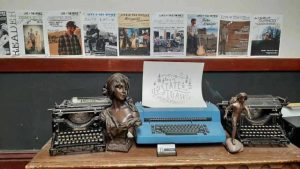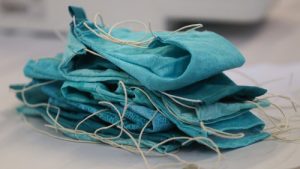Local journalism needs us.
April 6, 2020‘Journalism faces an extinction event.’ If you value democracy, please buy a paper today or subscribe to a news organisation. We are an industry that has been battling for years but COVID-19 is an existential threat to independent journalism everywhere.’
-Carole Cadwalladr, The Guardian & The Observer
Facing a possible “extinction event” for independent media worldwide, journalists must work together globally to combat a triple threat of disinformation, government restrictions and economic calamity worsened by the COVID-19 pandemic, three top editors said during an ICFJ webinar Friday.
Maria Ressa, the founder of Rappler in the Philippines, said that although her outlet is in a comparatively secure financial position, many other news organizations globally are at risk of collapse. And the result could be that many citizens might not be able to count on independent media to continue to provide factual information free of government control once the shock waves of the pandemic have subsided.
-The International Center for Journalists (ICFJ)
The Sandpoint Reader in Sandpoint, Idaho, was forced to lay off most of its staff after it lost advertising revenue due to the COVID-19 pandemic.
The Mountain West News Bureau
Newspapers Face Existential Question: How To Cover The Pandemic When There’s No Money?
By Nate Hegyi
Ben Olson is exhausted.
‘Olson appears close to burning out, trying to keep his readers up-to-date with the latest COVID-19 news. The region has dozens of confirmed cases and, like the rest of the country, that number is growing. But at the same time, the number of reporters and staff at the Reader has shrunk – from four down to just one: Olson.
“I want to get my staff back to work because, number one, they’re like my family and I feel responsible for them,” he says. “But number two – I just cannot handle this by myself.”
Olson had to lay off his staff after local restaurants and bars shut down in an effort to curb the spread of COVID-19. Those businesses often advertised events in the Sandpoint Reader’scalendar. But no events mean no money.
“I realized very quickly that I would probably make one or possibly two more payroll cycles and then I would be completely bankrupt,” he says.
It’s a problem that’s reverberating throughout the Mountain West’s media landscape. The COVID-19 pandemic is deepening the cracks and fissures in a centuries-old business model, one that traditional newspapers and alternative weeklies still rely on.
There are no journalists without robust advertising dollars to pay for them, and money from subscription and circulation revenues can only go so far – they often cover less than half of a newspaper’s expenses.
So, from the Sandpoint Reader to the Bozeman Daily Chronicle and Missoulian in Mont., to the Buffalo Bulletin in Wyo. and Westword in Denver, media companies are cutting hours and laying off staff.
“This is a real disaster for media that are supported by advertising in general,” says Ben Smith, a media columnist for the New York Times who recently wrote an op-ed titled “Bail Out Journalists. Let Newspaper Chains Die.”
He points out that many traditional newspaper chains were on life support before the pandemic – they’ve been cutting costs by shutting down papers and laying off staff. COVID-19 just sped up the clock and Smith doesn’t expect a happy ending.
“I think we’re going to wind up with fewer journalists next year than this year, just as it has been for the past several years,” he says.
“I think there is an increasing recognition that journalism is a public service,” he says. “It’s a utility like water or electricity, in terms of keeping a community going and is an appropriate outlet for philanthropy.”
It’s a business model that has been adopted by an increasing number of news outlets across the Mountain West. Late last year, The Salt Lake Tribune became the first legacy newspaper to transform itself into a nonprofit organization. Montana Free Press embraced the nonprofit model when it launched a few years ago.
“Most of our revenue comes from members who donate to us like they would to public radio,” says John S. Adams, editor-in-chief of Montana Free Press.
Currently the outlet is doing well financially, he says. They’ve seen skyrocketing readership and an uptick in donations during the pandemic.
This story was produced by the Mountain West News Bureau, a collaboration between Wyoming Public Media, Boise State Public Radio in Idaho, KUNR in Nevada, the O’Connor Center for the Rocky Mountain West in Montana, KUNC in Colorado, KUNM in New Mexico and with support from affiliate stations across the region. Funding for the Mountain West News Bureau is provided in part by the Corporation for Public Broadcasting.
Tools for Our Time
Wise, compassionate brilliance from Sara Gorham at Light on the Mountains in Ketchum [Sun Valley], Idaho.
When I was in my twenties, I did a lot of living and traveling in the far corners of the world, spending the better part of that decade improvising one adventure after another, generally without itinerary but always open to whatever showed up. In those days you couldn’t Google where to stay in Calcutta before you went to Calcutta. You just went, trusting that things would work out and generally they did. To be honest, that youthful boldness and assurance amazes me now, but at the time it seemed unremarkable, just a way of being.
Now, with all that is going on in the world, the daily challenges, the unknowable future, I’m starting to think it might be time for me to dust off that youthful assurance and the skill sets and assumptions that went with it. It would appear they could be useful in our current moment when none of us can Google what’s ahead. Instead, the road to what’s next is being laid one brick at a time, just ahead of our footsteps. So, what can we do to best prepare for the novelty of our unfolding future? If I were to take another tip from my younger self, I might suggest we pack light, for it isn’t stuff that we’ll need, but rather the skills and mindset that will help us land well, wherever we land. Here are three things we might consider, things that never failed to serve my younger adventuresome self: curiosity, adaptability and optimism.
We can be curious about the possibilities available to us, about what we might learn and what we might create as the old assumptions of separation fall away. Instead of casting about for what was, we can learn to be adaptable and open to the new “what is,” remaining centered in the moment as things change and evolve. And if we can hold an optimism in our hearts, an expectation for good, we can carry ourselves, not just forward, but upward, buoyed by our knowing that we are at our best and our truest when we are led by our love and caring and not driven by our fears.
We are being gifted with a common experience. It is not an easy passage. We do not make light of the grief and suffering that is part of this experience, but it does afford us a view of our unmistakable unity, of our commonality of being. Let us not waste that realization. I have no doubt that the seas will eventually calm and that the ship we’re sailing will once again right itself, but I suspect that when our ship makes landfall, we will find ourselves on an altered shore, a new horizon. The good news is that our role is not just to arrive at our new horizon, but to co-create it. To best do that we need to be aware and intentional, mindful of our mindset and ready to use our best skill sets, so that the post-pandemic culture we create reflects the heart of our shared humanity and the very best within us all.

